What Is a Pool Sand Filter? Cost, Maintenance, Benefits
September 12th, 2020
8 min read
By Guest Author

Did you know that the ancient Greeks used sand filters to clean their bathhouse pools?
That's how old the sand filter technology is, but don't let that be a drawback. Some of the greatest inventions thought up centuries ago continue to be used to this day.
If you're a new pool owner or if you're looking to switch up your filtration system, you may have questions like:
"What is a sand filter? How does a pool sand filter work? Is a sand filter better than a cartridge system? How much does a sand filter cost?"
If you've got one or more of these questions on your mind, we've got your back.
At River Pools, we manufacture fiberglass swimming pools and run one of the world's most trafficked swimming pool websites. Because our focus is on educating pool owners and pool shoppers, we try to cover the essential maintenance topics and pool products that they work with every day.
In this article, we'll explore sand filters in detail to help you decide if it's the right choice for your pool before you invest in one. By the end, you should have a better idea about whether a sand filter is a good option, how much it might cost, how to maintain it, how it compares to other types of filters, and more.
Pool Sand Filters
.jpg?width=500&height=300&name=unnamed%20(10).jpg)
What Is a Sand Filter?
A sand filter is essentially a tank full of sand that's connected to your pool's filtration system. As pool water passes through the sand tank, the sand catches debris and particles and prevents them from returning to the pool. This results in cleaner, clearer water.
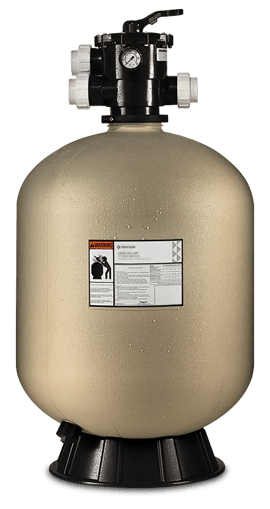
Most sand filters use #20 sand, or mesh crystal silica #20, but they may also use glass or zeolite. The sand filter housing is typically made from stainless steel, fiberglass, or plastic and is durable enough to withstand the high pressure required to run the filtration system.
How Does a Sand Filter Work?
Sand filters function by moving the water from the top of the tank through the sand to the bottom of the tank via high pressure. As the water trickles down, the sharp edges of the sand grains catch particles like dirt, debris, and body waste materials. Smaller and smaller particles are removed from the water as it cycles through until the sand becomes too dense and needs to be cleaned, AKA backwashed.
Backwashing Your Sand Filter
To cleanse the sand, the sand filter will need to be backwashed (manual or automatic). Backwashing your sand filter reverses the flow of water through the sand, starting from the laterals at the bottom and working its way up to top, collecting debris and particles as it goes.
Once it works its way to the top of the filter, it is then sent to waste (meaning it will be disposed of and won't return to the pool). Backwashing can be completed within minutes and isn't a labor or time-intensive process.
After the backwashing cycle is complete and the system has been rinsed, the clean sand can restart the process of filtering the pool water once again.
Anatomy of a Sand Filter
If you want to learn exactly how water moves through a sand filter system, keep reading because we're going to explain how the different parts of the filter come into play. If you'd rather get more information on pricing and maintenance, feel free to skip this section.
Pool water enters the sand filter at the top of the tank, and it always begins filtering from there. Meaning, if the water enters from a pipe at the side of the tank, it will need to be pumped to the top to begin the filtration cycle.
You can think of it like a fountain. The water can enter a fountain from any direction, but no matter what, the water needs to trickle down from the top tier.
Once at the top of the sand filter tank, the pool water goes through a distributor to ensure it's evenly spread over the sand bed.
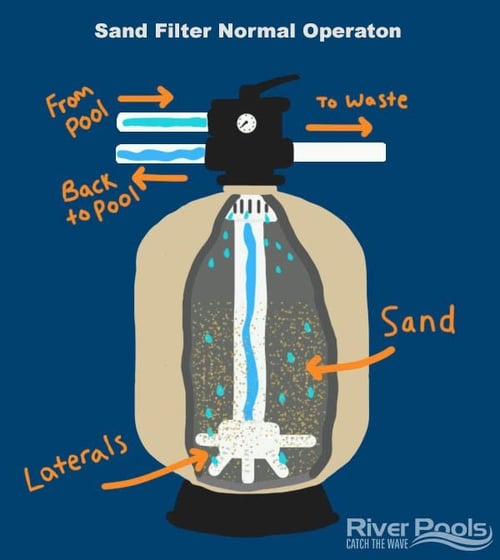
The pool water then washes through the sand leaving behind impurities before arriving at the laterals located at the bottom of the tank. The lateral openings are just large enough to let the water pass through but too small for sand to squeeze by and end up in the pool.
During the backwash process, the water comes out of the laterals at the bottom and travels up the sand and through the distributors at the top to waste.
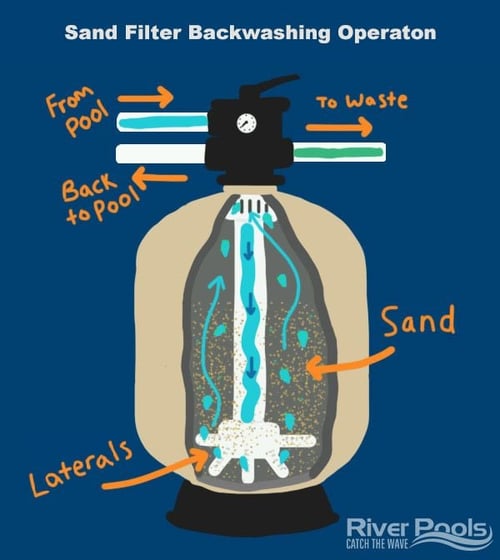
Note: The configuration and parts of your sand filter will vary by model.
How Much Does a Sand Filter Cost?
A new sand filter can cost anywhere from about $300 to more than $1,000 on average. Inground pool sand filter prices range between about $450 to over $1,200, depending on the size. Above ground pool sand filters are often cheaper at starting costs in the $300 to $500 range.
Sand Filter Sand Cost
Replacement sand for your sand filter typically costs around $18-30 per 50-pound bag, and your filter may require 100 to 600 pounds or more, depending on the size and model. More than likely, you'll need about 350 pounds of sand for an average-sized inground pool filter.
However, the main expense when it comes to your sand filter will be purchasing and setting up the unit itself.
Sand Filter Maintenance
Sand filters are relatively easy to maintain, but they still require some hands-on work. Let's take a look at what that might include.
Sand Filter Cleaning
As a standard, your sand will be cleansed when you backwash and rinse the sand filter. Sand filter sand can last five to seven years, but more than likely, you will replace it every three years or so. Baquacil users may find that they need to replace the sand every year because it tends to coagulate the impurities in the tank.
Pro tip: If your sand develops clumps, you can soak your sand in a filter cleaner to remove them.
Sand Filter Sand Replacement
For a general overview of how to replace the sand in your sand filter, here are the steps:
- Drain the water from the tank and remove the filter head.
- Scoop or shop-vac out the old sand from the tank.
- Fill the tank up to the halfway point with water.
- Add sand filter sand according to your manufacturer's instructions.
- Re-attach the filter head and backwash the water for 30 seconds.
- Return filtration to "filter" mode and double-check for leaks.
Note: You must follow directions carefully when replacing your sand. Specifically, when doing your sand replacement, follow your manufacturer's instructions, and wear an appropriate face covering when handling filter sand.
Also, be sure to follow the instructions when determining how much sand to add to the filter and when running your backwash startup cycles.
Pay attention to how much free space, or freeboard, you leave when adding new sand. Typically, it needs to be half the depth of the sand bed, but you can double-check by looking for markings on your tank or reading your user manual. (Your sand filter manufacturer should provide instructions for the amount of sand you need to add to have a balanced sand to freeboard ratio.)
Sand Filter Replacement: How Long Do Sand Filters Last?
Your sand filter can last anywhere from 15 years to 25 years or more if cared for and maintained well. Most of the time, you may need to replace parts like valves and gaskets, but you probably won't need to replace the whole system for many years.
When it is time to replace your sand filter with a new unit, make sure you get the appropriate size and set up the new filter according to the manufacturer's instructions. Equally important, be sure to match the new sand filter to your pool pump's flow rate.
What Size Sand Filter Do I Need?
The sand filter size that you need will depend on your pool's size and how many gallons of water it holds. Most inground pools up to 20,000 gallons will require a sand filter that is 24 inches in diameter while pools over 50,000 gallons will need a sand filter that is 36 inches in diameter (the largest size). Pools with volumes ranging from 20,000 to 30,000 gallons will require a 24-inch to 30-inch tank.
When determining the right size, you can go up a size, but avoid downsizing as that can overload the system.
Which Pool Types Work Best with Sand Filters?
All inground pools can function using a sand filter, including fiberglass, concrete, vinyl liner, and other prefab pools like container pools. Above ground pool owners (soft side and rolled wall) also commonly use sand filter systems.
In the end, the pool type won't affect what kind of filtration system that you can have or how effective it can be as long as the filter size is matched to the size of the pool. Be sure to factor in the number of hours that you plan to run your filter every day to calculate an accurate turnover rate.
Pro tip: Check the filter's "Turnover Capacity in Gallons" on the spec sheet before you buy.
Read more: What Does a Pool Filter's Filtration Area Mean?
Sand Filter vs. D.E. Filter
A D.E. filter consists of a set of grids coated with a white powder made up of crushed seashells and fossilized diatoms (AKA diatomaceous earth). These filters can catch dirt and debris 5 microns and bigger.
Crushed seashells and fossils might sound like a weird way to clean your pool, but a D.E. filter looks like any other pool filter and functions similarly. The main difference is in how it works and how it is maintained.
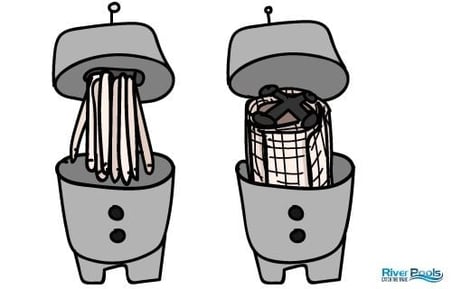
The diatomaceous earth is layered over a mesh to form a fine screen. As the water passes through the system, the D.E. traps particles and debris and keeps it from going back into the pool. Like a sand filter, D.E. filters need to be backwashed to clear out stuck debris and particles before resuming regular filtration, and backwashing may need to be repeated several times. Manual cleaning of the grids is required about every 90 days.
Warning: D.E. powder can be hazardous to handle. Please use appropriate face and eyewear while servicing your filtration system.
Are D.E. Filters Better?
D.E. filters are more expensive than sand filters, and they are more work to maintain. The D.E. powder also needs to be continually added to the system to keep the filtration process going, whereas sand can go years without being replaced. On the flip side, they produce clearer water and trap much smaller particles than sand filters.
Sand Filter or Cartridge Filter: Which Is Better?
A cartridge filter uses pleated fabric wrapped around a cylindrical core to filter pool water and catch debris as it goes through the system. Cartridge filters are used on pools and spas, are compact in size, and don't need to be backwashed. They are also easy to maintain as they only need to be rinsed with a hose about every four to six weeks, depending on the size. The filter might need to be soaked in a filter cleaning solution on occasion, especially if you've been having trouble with algae.
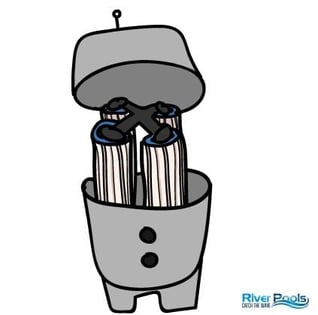
In our personal opinion, cartridge filters are more effective at removing impurities and keeping the pool water clear than sand filters. Cartridge filters are also easy to maintain, catch smaller particles than sand filters, reduce the load on the pool pump, and don't require any backwashing. As a bonus, you won't need to handle potentially dangerous materials (sand, silica, zeolite, etc.).
Read more: Proper Filtration: The Heart of Your Pool's Water Clarity
Should You Get a Sand Filter?
Now that you have a basic overview of what a sand filter is, how it works, how much it costs, and how it compares to other filter types, let's go over the pros and cons that you need to consider before you get one.
Sand Filter Pros and Cons
Pros:
- Sand can last 5-7 years without needing to be replaced, but it will most likely last 3.
- Replacement sand is relatively cheap.
- Sand filters are easy to maintain.
- Sand filters are commonly used and easily serviced.
Cons:
- The pressure from a sand filter can be dangerous. For safety reasons, always follow your pool's filter instruction manual.
- The water clarity isn't as clear as sand filters can't remove particles as small as cartridge and D.E. filters can.
- The laterals in the sand filter can break, causing sand to make its way into the pool.
We hope that this has helped you decide if a sand filter is a good option for your swimming pool. Before you go, we want to leave you with a few words of wisdom that apply to every pool owner: Don't fall behind on your pool maintenance chores. The better you maintain your pool and sand filter, the better they will look and function in the long-run.
The Greek philosopher Aristotle said it best:
"We are what we repeatedly do. Excellence, then, is not an act, but a habit."
At River Pools, we manufacture world-class fiberglass pools for customers across North America. If you are interested in getting a fiberglass inground pool for your home, you can browse our pool models to explore your fiberglass pool shape options, or request custom pricing using the button below. For a fast estimate, try out our free pool pricing calculator today!
Up Next:
Inground Swimming Pool Maintenance Costs: Chemicals, Electricity, and More
12 Outdoor Living Space Accessories to Add to Your Home
The Ultimate Guide to Inground Swimming Pool Maintenance
Editor's note: This article was originally written by Jason Hughes and was updated on December 18, 2024, with current information. River Pools is a brand of inground fiberglass pools produced in a manufacturing facility in Fortville, IN. While our expertise is in manufacturing fiberglass pools, we have access to a network of installers with expertise relating to project design, installation, and pool service. We often tap into this knowledge base and share information freely with homeowners, just like you, considering installing a swimming pool in your backyard.
Topics:


